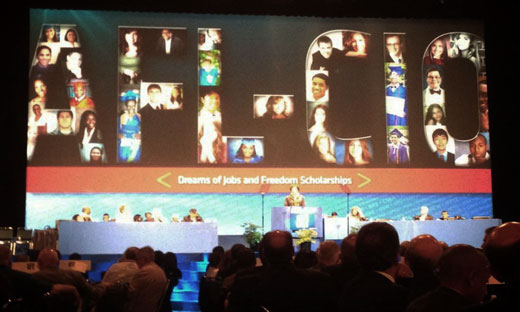
Coming out of the AFL-CIO quadrennial convention three weeks ago pumped up for action, unionists and their allies are wasting no time carrying out the decisions of what was a trail-blazing convention.
The AFL-CIO announced last week that it has entered a new national partnership with the college-based United Students Against Sweatshops (USAS), which will make the campaign to organize T-Mobile workers into the Communication Workers of America (CWA) a priority.
Not in the news but also significant, the federation’s recent convention revealed that thousands of union members at T-Mobile and Deutsche Telekom in Germany have taken up their U.S. counterparts’ cause and are protesting their company’s treatment of them.
T-Mobile U.S. workers now can count on the solidarity of students, other consumers, and workers abroad who together could potentially exert economic and public pressure affecting the company’s bottom line and willingness to bargain.
This is but one example of the far-reaching initiatives the AFL-CIO and several affiliates have begun to take in recent years to strengthen international labor cooperation, including mergers, to leverage labor’s power in a global economy dominated by capitalist transnational corporations and financial institutions.
Indeed, the AFL-CIO convention projected an agenda and a vision aimed to transform the labor movement, its partners and allies into a formidable 21st century people’s force for economic justice and democracy.
The convention mapped out a modern-day agenda akin to wall-to-wall organizing of the 1930s CIO that resulted in the unionization of the nation’s industrial base during a decade of powerful popular upsurge that saw the enactment of the then-progressive National Labor Relations Act, Social Security and Unemployment insurance.
The program projected by the AFL-CIO today, in a process begun a few years back, could potentially become even more consequential given the national and international links set in motion at the convention.
Drawing on the 1960s civil rights era’s transformative impact on today’s social environment, AFL-CIO leaders and delegates set out to change the labor movement’s composition from top to bottom.
The full integration of women, people of color, immigrants, youth, LGBT and other specially oppressed people into all aspects of the federation’s operations is to bring together this overlapping kaleidoscope of human categories – including white men – into joint struggle over common needs.
At the same time, in several unanimously-approved resolutions, the convention took into consideration the particular needs of the working class’ “diverse” components, making the needs of each the cause of the entire labor movement.
In response to institutionalized racism and the rightwing assault on the democratic rights of people of color, the convention moved to condemn the rise of the private-for-profit prison system and the “school-to-prison pipeline” disproportionally impacting African American and Latino young people. The convention proposed a set of far reaching progressive reforms to address this crisis.
Given the persistent ideological influence of racist notions among sections of the white population, it was heartening to see a multiracial group of delegates who spoke thoughtfully on behalf of the resolution including white delegates, starting with AFL-CIO President Richard Trumka from the podium.
No less resolute
No less resolute were the convention’s actions on women’s rights reflected in a comprehensive resolution and the spirited participation of women and men.
In a sign of the growing unity between labor and the women’s movement, the President of the National Organization of Women Terry O’Neill linked the corporate right-wing’s “relentless assault on women’s economic security” with the attack on women’s reproductive rights, which the resolution also addressed.
Particularly encouraging is the energetic way in which the AFL-CIO and several affiliates are preparing a new generation of young labor leaders and activists.
The AFL-CIO leadership was the first to admit there is a ways to go on this and other fronts.
But in the convention, in the conference on building a diverse movement immediately preceding, and in the wide-ranging public discussions during previous months, it was refreshing to witness the self-critical way the challenges were evaluated, with an eye to finding productive solutions and then acting on them.
The progress on all fronts is remarkable, given that until former President John Sweeney’s team – including current President Trumka as secretary-treasurer – won the federation’s top leadership in 1995 the AFL-CIO had been in the hands of top leaders who had pursued center-right policies since the 1950s McCarthy witch hunts that purged communist and progressives from the trade union movement.
At the AFL-CIO convention the refrain, “diversity and inclusion,” came into play in other unprecedented ways.
The convention agreed to step up efforts to organize all workers whether covered by collective bargaining agreements or not, whether protected by labor and social laws or not.
These include undocumented workers, taxi drivers classified as independent contractors to deprive them of labor law protections, and domestic workers excluded from the 1938 Fair Labor Standards Act, whose causes and leaders were heralded at the convention.
Last week California became the nation’s third state to enact a Domestic Workers Bill of Rights with the pivotal involvement of labor in broad coalition with civil rights, women, youth, interfaith, and community groups.
These are precisely the social movements represented at the convention with which the federation is forging closer relations in action, in some cases even formal partnerships as with Workers Centers and USAS.
The convention launched Working America, previously tested successfully in a few states, as a national formation. Any one not belonging to a union can join whether employed or not and for a small fee be entitled to modest benefits.
The convention called upon “all” AFL-CIO unions and Working America to “develop forms of workplace representation and advocacy that can benefit members outside collective bargaining agreements by educating them about their workplace rights, providing assistance when their rights are violated, and encouraging concerted action to redress workplace grievances.”
Will continue as the vehicle
Working America will continue to be a vehicle for registering workers to vote, and educating and mobilizing them into electoral and legislative campaigns alongside their unionized counterparts.
Perhaps nothing spoke louder about how seriously the AFL-CIO takes the 2014 midterm elections than the fight for immigration reform with a path to citizenship.
During the August Congressional recess, the AFL-CIO, immigrant rights and other allied groups led a blitz of visits to Republican House members’ offices, demanding they act on the Senate version of the immigration bill or pay the consequences during next year’s midterm national elections.
Flanked by leaders of unions and labor-community groups, Maria Elena Durazo, head of the Los Angeles Federation of Labor and chair of the national federation’s Immigration Committee, told a convention press conference: “We will not let Congress put this issue on the back burner!”
True to its word, the federation announced last week that on October 5 it would take to the streets with allies in a National Day of Action in over 30 states and dozens of cities for a vote on immigrant rights with a path to citizenship.
As a recognition of the critical role of immigrants in the nation, the convention elected as its new Executive Vice President Tefere Gebre, a native of Ethiopia, who had been the head of the Orange County Labor Federation.
Gebre, an innovator credited with helping transform a county once a bastion of conservatism, is expected to help fortify the role of local labor councils and state federations, pivotal to broad unity of action on the ground.
Major problems still remain, not least of which is the power of transnational capital and the dominant grip of the corporate elite over the economy and political and social institutions, especially far-right sections concentrated in the Republican Party out to destroy the fighting capacity of the labor movement and its allies.
But even within labor’s ranks, challenges to unity, such as reunification, require urgent attention.
Great strides have been made on that front with the return to the AFL-CIO of UNITE HERE, the Laborers and the United Food and Commercial Workers.
But SEIU, the Teamsters, the United Farm Workers and the ILWU, which pulled out on the eve of the convention, are still out.
In some cases, jurisdictional disputes are a problem, both between AFL-CIO affiliates and with those outside the federation’s fold.
While the immediate solution may be for the federation’s leadership to be more aggressive in seeking mutually satisfactory solutions, the real answer lies elsewhere, as Trumka told a convention press conference.
Instead of fighting
Trumka said that instead of fighting over the 11.2 percent who are already organized into unions, labor ought to be fighting together to organize the other 88-plus percent who are not.
That kind of unifying strategy could open the door to a coordinated drive for massive organization of the unorganized – employed, underemployed and unemployed – in which the whole labor movement, its allies and, most importantly, the whole working class and allied social forces would be the winners.
These unprecedented initiatives exhibited at the convention were precipitated by a general feeling that the labor movement is in crisis largely due to the ferocious corporate counteroffensive of the last thirty-plus years and the resulting loss of union members.
Nevertheless, as Trumka said in his convention keynote, the AFL-CIO is still “the biggest, strongest, best organized force for economic justice in America.”
As developments on the ground show, the AFL-CIO constitutes the core of a broad people’s coalition for economic justice and democracy.
In announcing the new partnership with USAS this week, Trumka said, “We have to change the way we’re doing business in a significant way to get out of the crisis we find ourselves in.”
“But,” he added, “this crisis also offers us ample and tremendous opportunity.”
Photo: bctgm.org












Comments